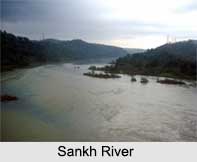 Sankh River has its origin at the Chhotanagpur region of Jharkhand and joins with Koel River at Panposh near Rourkela of Sundargarh District, Odisha. The meeting place of Sankh and Koel is believed to be a holy place and visited by thousands of pilgrims. River Brahmani enters into Angul District through the Rengali Reservoir. The larger Sankh River meets its four distributaries nearby Samakoi, Tikira, Singrajhor and Nandira in Angul district. The river finally empties into Bay of Bengal after flowing across Jajpur and Kendrapara district.
Sankh River has its origin at the Chhotanagpur region of Jharkhand and joins with Koel River at Panposh near Rourkela of Sundargarh District, Odisha. The meeting place of Sankh and Koel is believed to be a holy place and visited by thousands of pilgrims. River Brahmani enters into Angul District through the Rengali Reservoir. The larger Sankh River meets its four distributaries nearby Samakoi, Tikira, Singrajhor and Nandira in Angul district. The river finally empties into Bay of Bengal after flowing across Jajpur and Kendrapara district.
Course of Sankh River
Sankh River starts thousand meters above the sea level from Lupungpat village and is located at Gumla district, Jharkhand. It flows for 67 kilometres and then it enters into Chhattisgarh. It covers a distance of 50 kilometres in Chattisgarh and then it enters in Jharkhand for next 76 kilometres. Finally it enters into Odisha after covering a distance of 40 kilometres and merges with Koel River. The Sadni falls has a height of 60 meters that falls on Sankh River at the edge of Ranchi plateau.
This article is a stub. You can enrich by adding more information to it. Send your Write Up to content@indianetzone.com.



















